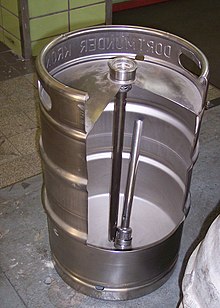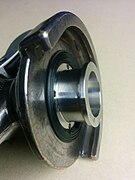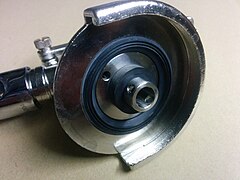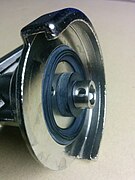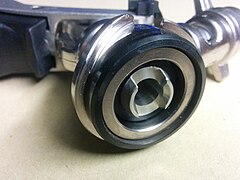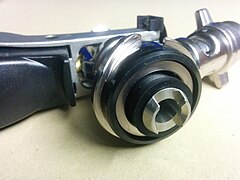Keg
The keg ( keg 'small barrel' ) is a reusable barrel that was specially developed for industrial filling and sterile storage of beverages. The system was introduced in Great Britain in 1964 . Kegs have become widely accepted in the hospitality industry outside the UK; In the private sector, too, dispensing systems with corresponding devices are increasingly to be found. Usual keg sizes are 30 liters and 50 liters.
Due to the increase in English words in German usage, the word keg is now also used in other barrel sizes and systems, but mostly limited to the designation of branded articles .
Structure and functionality
The keg is a cylindrical barrel made of stainless steel . Modern kegs are often rubber coated to protect the container from damage. The jacket also insulates the barrel; this means that the contents stay cool longer, but a longer cooling time is required to bring them to the desired temperature.
A valve , the so-called keg head, is attached to the top in the middle . A suitable tap head can be attached to this, which supplies propellant gas ( carbon dioxide , in certain cases also nitrogen ) from an external container and discharges the contents to the tap system. The tap head seals the keg tightly, which means that if the hose lines and devices are in the appropriate condition, tapping the keg and transporting it to the glass are virtually sterile.
The propellant creates an overpressure in the keg, and when the tap is opened, the contents are forced out through a pipe inside the keg . If the tap head is removed, the valve closes the keg airtight, which enables the contents to be stored further and prevents the remains from drying out. The overpressure inside the keg is maintained and the contents do not foam up.
Connection systems
The four connection systems mainly used by German breweries have been named with different types (letters) for better differentiation.
Flat tap head (type A) and combination tap head (type M)
At first glance, these two tap heads hardly look different. They are both pushed onto the side of the valve and only differ in the middle tappet, which opens the valve by pressing into the barrel. The flat tap head (type A) is a kind of "bell", while the combination tap head (type M) only has a small piercing tube and is surrounded by a perforated ring .
In spite of the same type of attachment, these two systems are not compatible with each other or can be exchanged crosswise.
Basket dispensing head (type S) and draft dispensing head (type D)
These two tap heads look similar, but unlike the ones mentioned above, they are “screwed” onto the keg. With the cage tap head (type S), the center plunger is longer than in the draft tap head (type D) and can be recognized by the V-cutouts on the side.
KeyKeg
The proprietary connection variant KeyKeg is used exclusively for the one-way kegs from Lightweight Containers BV . This tap head is placed on the fitting from above and then rotated by 60 ° to fix it. The barrel is then tapped by pressing the lever down.
If the user does not have several tap heads, he can only pierce the kegs that match his system.
Cleaning and filling
At the beverage manufacturer, the filling can be carried out fully automatically through the valve system. After the external cleaning, the keg is rinsed several times and then any germs that can spoil the beer are killed with hot steam ( sterilization ). The tightness is then checked. In order to cool down the keg from the steam treatment and to prevent the contents from foaming during filling, it is pressurized with carbon dioxide and then filled.
Labelling
Some breweries mark their kegs with colored bands around the keg so that you can see what is in the keg. For example, Karlsberg is marked blue-black and Bitburger green. But the most common way of marking a keg barrel is with the so-called fitting lid. This cover is made of flexible or hard plastic and is pressed onto the fitting. You can now put the desired data on it with the help of stickers. The advantage here is that you can always fill the kegs with different types of beer.
Design
In Germany, designs were essentially determined by the standards DIN 6647-1 and DIN 6647-2, called "Cylindrical beverage and raw material containers, nominal volume up to 50 l" (part 1 to 3 bar and part 2 to 7 bar) in the last version from 1998. Added to this is DIN 3542 “Barrel sleeves and barrel connection parts, connection dimensions” and DIN 32677 “Line connection parts for beverage dispensing systems, connection dimensions” for the tap connections.
| Content (liter) | Content (US.liq.gal) | Size according to DIN 6647-1 / -2 (height × diameter) |
Size of a euro keg (height × diameter) |
|---|---|---|---|
| 50 l | 13.21 gal | 600 mm × 363 mm | 532 mm × 408 mm |
| 30 l | 7.93 gal | 400 mm × 363 mm | 365 mm × 408 mm |
| 25 l | 6.61 gal | - | 395 mm × 327 mm |
| 20 l | 5.29 gal | 310 mm × 363 mm | 395 mm × 216 mm |
Euro kegs are used more and more in Germany to replace the DIN design. While the DIN kegs are measured in 50, 30 and 20 liters, the Euro kegs come in 50, 30, 25 and 20 liters - in addition to the 50-liter keg size, 25 liters is the next smaller delivery size. The Euro kegs are lower and thicker with the same content - a 50 liter stainless steel keg is 600 mm high and 381 mm in diameter for DIN and 532 mm in height and 408 mm in diameter for Euro kegs.
| Content (US.liq.gal) | Content (liter) | designation | Design (height × diameter) |
|---|---|---|---|
| 15.5 gal | 58.67 l | Full keg / half barrel | 23 3 ⁄ 8 inch × 16 1 ⁄ 8 inch (≈ 594 mm × 410 mm) |
| 7.75 gal | 29.34 l | Quarter barrel / pony keg | 13 7 ⁄ 8 inch × 16 1 ⁄ 8 inch (≈ 352 mm × 410 mm) |
| 7.75 gal | 29.34 l | Slim Quarter | 23 3 ⁄ 8 inch × 11 1 ⁄ 8 inch (≈ 594 mm × 283 mm) |
| 5.16 gal | 19.55 l | Sixth barrel | 23 3 ⁄ 8 inch × 9 1 ⁄ 4 inch (≈ 594 mm × 235 mm) |
| 5 gal | 18.925 L. | Cornelius | 23 inch × 9 inch (≈ 584 mm × 229 mm) |
| 1.32 gal | 5.0 l | Mini | 9 7 ⁄ 8 inch × 6 3 ⁄ 4 inch (251 mm × 171 mm) |
| 6.6 gal | 25 l | Euro half barrel | 395 mm × 327 mm |
In the United States , the 15.5 US-gallon (full-keg) size is most common, more commonly referred to as a "half-barrel", and the next smaller size is a quarter barrel with 7.75 US gallons. The most common size of 50 liters in Europe is traded as "Import Keg" or "Euro Barrel". The information on gallons is “ US liquid gallon ” of 3.7854 liters and not the imperial gallon with 4.546 liters - the European 50-liter barrel corresponds almost exactly to a volume of 11 imperial gallons (this 50 -l- or 11-imp. gall. barrel is the most common barrel size in Great Britain).
Web links
- Technical information on the keg , with illustrations
